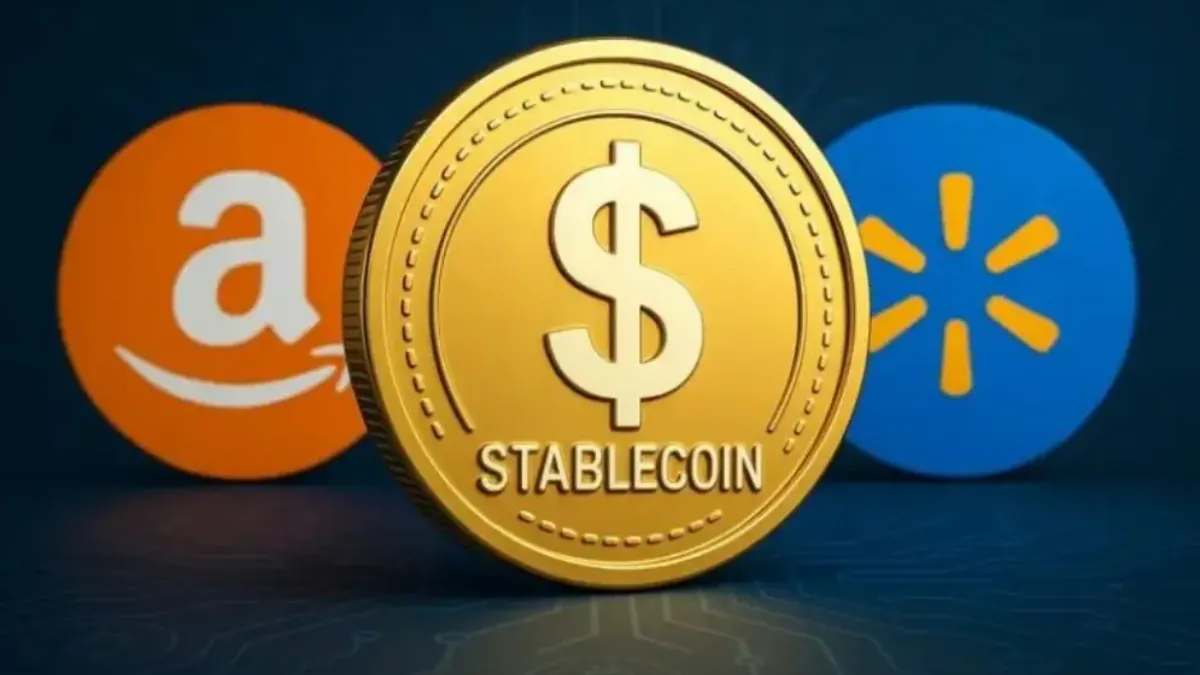As cryptocurrencies gain prominence in global finance, retail titans Amazon and Walmart are investigating the issuance of their own dollar-backed digital currencies to revolutionize payment systems and reduce operational costs. A June 13, 2025, report from The Wall Street Journal revealed that both companies are in the preliminary stages of exploring stablecoins—cryptocurrencies pegged to the U.S. dollar—to enhance transaction efficiency and streamline cross-border payments. This development, bolstered by recent U.S. regulatory advancements, marks a significant step in integrating blockchain technology into mainstream commerce, potentially reshaping how global retailers manage financial transactions and engage with customers.
Stablecoins: A Path to Financial Efficiency
Stablecoins are designed to maintain a stable value, typically backed 1:1 by assets like the U.S. dollar, making them an attractive alternative to volatile cryptocurrencies such as Bitcoin or Ethereum. For Amazon and Walmart, which collectively process hundreds of billions in transactions annually, issuing proprietary stablecoins could significantly reduce reliance on traditional payment systems like credit cards and bank transfers, which incur high processing fees and lengthy settlement times. A CoinDesk report from June 24, 2025, highlights that stablecoins can enable near-instantaneous payments, particularly for cross-border transactions, where conventional banking systems often take days to clear.
Industry sources, cited by Reuters on June 25, 2025, indicate that Amazon and Walmart aim to modernize their payment infrastructures through stablecoins. For instance, Walmart could use a stablecoin to facilitate real-time payroll for employees in regions with limited banking access, addressing challenges outlined in a 2024 World Bank report on financial inclusion. Amazon, meanwhile, could leverage stablecoins to pay international vendors swiftly, bypassing costly intermediaries like wire transfer services. A Standard Chartered analysis from May 2025 estimates that such efficiencies could save retailers billions over time, particularly at the scale of these companies’ operations. Beyond cost savings, stablecoins could enable innovative customer engagement strategies, such as tokenized loyalty programs offering cashback or rewards, though no official plans have been confirmed. The potential for stablecoins to streamline operations while enhancing customer experiences underscores their appeal to retail giants, as noted in a Bloomberg report from June 20, 2025.
The technical feasibility of stablecoin issuance is supported by both companies’ existing blockchain expertise. Walmart has utilized blockchain for supply chain tracking since 2018, as detailed in a company press release, improving transparency in logistics. Amazon’s AWS division powers numerous blockchain projects, including those for major cryptocurrencies, positioning it as a leader in the digital economy. These foundations make stablecoin issuance a logical extension of their current strategies, though insiders emphasize that plans remain in the research phase, with no set timeline for implementation.
Regulatory Clarity Fuels Corporate Blockchain Adoption
The exploration of stablecoins by Amazon and Walmart aligns with a broader corporate shift toward blockchain technology, driven by increasing regulatory clarity in the U.S. On June 17, 2025, the U.S. Senate passed the Guiding and Establishing National Innovation for U.S. Stablecoin Act (GENIUS Act) with a 68-30 vote, establishing the first federal framework for stablecoin regulation, according to a PYMNTS.com report. The legislation, now under review in the House, mandates fully reserved assets and anti-money laundering compliance for issuers, reducing legal uncertainties for corporations. A CoinGeek report from June 23, 2025, links the Act’s passage to heightened corporate interest, noting that it provides a stable environment for firms like Amazon and Walmart to pursue digital currency initiatives.
Other industry leaders have already embraced stablecoins. Visa and PayPal have integrated USDC into their payment platforms, as reported by Bloomberg on June 20, 2025, while JPMorgan has developed its own blockchain-based payment solutions. @WatcherGuru and @DeItaone both posted commentary about this on x.com on June 13, 2025, reflecting public enthusiasm for this trend, with many viewing corporate stablecoins as a transformative force in retail payments. The GENIUS Act’s framework addresses longstanding concerns about stablecoin stability, particularly after high-profile failures like TerraUSD in 2022, as noted in a Reuters analysis from June 2025. By establishing clear guidelines, the Act encourages corporations to explore stablecoins without fear of regulatory backlash, a sentiment echoed in industry discussions on X.
Amazon and Walmart’s prior blockchain experience enhances their readiness for stablecoin ventures. Walmart’s blockchain-based supply chain system, implemented with IBM, has tracked products like produce and meat, reducing waste and improving efficiency, according to a 2019 company report. Amazon’s AWS supports blockchain networks like Ethereum and Hyperledger, serving clients across finance and logistics, as detailed on its public website. These capabilities position both companies to develop robust stablecoin ecosystems, potentially integrating them with existing digital infrastructures to maximize efficiency.
Shaping the Future of Retail and Finance
The potential for stablecoins to transform retail payments is vast, offering fast, secure, and low-cost transactions that align with the needs of global retailers. For Amazon, a dollar-backed stablecoin could streamline payments to suppliers across Asia, Europe, and Latin America, reducing the costs and delays of international wire transfers, which can take up to five days, per a 2024 SWIFT report. Walmart could use stablecoins to enhance financial inclusion, enabling transactions in underserved regions where banking infrastructure is limited, as highlighted in the World Bank’s 2024 report. These efficiencies are critical at the scale of Amazon and Walmart’s operations, which span millions of transactions daily across dozens of countries.
The stablecoin market is poised for significant growth, with Standard Chartered projecting a $2 trillion valuation by 2028 if adoption trends continue, as cited in a CryptoNinjas report from June 22, 2025. This growth is driven by both consumer and enterprise applications, with platforms like Shopify integrating USDC for e-commerce, as announced on June 10, 2025. Stablecoins offer a programmable alternative to traditional payment methods, enabling features like automated escrow or smart contracts, which could further optimize retail operations, according to a CoinDesk analysis from June 24, 2025. However, challenges remain, including competition from established payment networks like Visa and Mastercard, which are unlikely to be disrupted in the near term, per a Barron’s report from June 2025.
If Amazon and Walmart proceed with stablecoin issuance, their involvement could legitimize digital currencies further, encouraging other retailers to follow suit. Their entry could also drive consumer adoption, making stablecoins as commonplace as loyalty points or branded credit cards. However, questions linger about implementation, including how these stablecoins will integrate with existing payment systems and whether they will prioritize operational efficiencies or customer-facing incentives. Regulatory hurdles, such as compliance with international financial laws, and technical challenges, like ensuring blockchain scalability, will also shape their strategies, as noted in a Reuters report from June 25, 2025.
As Amazon and Walmart navigate this transformative landscape, their exploration of stablecoins underscores a broader shift toward a digital-first financial ecosystem. With the GENIUS Act providing regulatory clarity and their existing blockchain expertise, both companies are well-positioned to lead the charge. The retail giants’ next steps will be closely watched, as they could redefine how businesses and consumers interact in an increasingly digital economy, paving the way for faster, more inclusive, and cost-effective financial transactions worldwide.
















